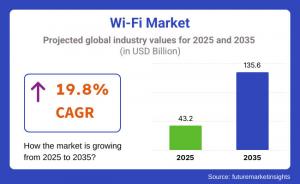Wi-Fi Market to Soar by USD 135.6 billion by 2035, Driven by Demand for High-Speed Connectivity and Smart Infrastructure
Wi-Fi market is expanding rapidly, fueled by growing demand for seamless connectivity, smart infrastructure, and IoT integration across sectors.
The rise in smart devices, cloud computing, IoT integration, and work-from-home practices has significantly increased the demand for reliable and fast wireless communication. Governments and urban developers worldwide are heavily investing in smart infrastructure projects that require comprehensive wireless coverage, thus further fueling market growth. Next-generation Wi-Fi technologies such as Wi-Fi 6 and Wi-Fi 7 are being deployed to meet growing data consumption needs and enhance network efficiency in high-density environments. Enterprises are increasingly adopting managed Wi-Fi solutions for campus connectivity, while telecom operators are integrating public Wi-Fi hotspots with their 5G rollouts to enhance service continuity. Additionally, educational institutions, healthcare facilities, retail spaces, and manufacturing sectors are leveraging advanced Wi-Fi to support digital transformation, automation, and real-time communication.
Propel Your Success: Secure Your Sample of Our Insightful Report Now!
https://www.futuremarketinsights.com/reports/sample/rep-gb-1876
Key Takeaways from the Wi-Fi Market:
The global Wi-Fi market is expected to expand from USD 43.2 billion in 2025 to USD 135.6 billion by 2035, registering a CAGR of 19.8%, underpinned by the rising need for seamless and high-capacity wireless connectivity across diverse environments. The proliferation of smartphones, tablets, smart TVs, and IoT devices has intensified the need for reliable Wi-Fi networks capable of supporting multiple concurrent connections. The growing reliance on cloud-based services, remote work, and real-time video communication has further increased bandwidth consumption, necessitating faster and more efficient wireless technologies. Wi-Fi 6 and the emerging Wi-Fi 7 standards are addressing these demands by delivering higher throughput, greater device capacity, improved power efficiency, and reduced latency.
Commercial and enterprise segments are among the fastest-growing end-users of Wi-Fi technology, given the importance of network security, scalability, and management flexibility in these environments. Residential demand is also booming, driven by the increasing number of smart home devices, online streaming, and remote education. North America currently dominates the Wi-Fi market due to early adoption of advanced technologies and strong digital infrastructure. However, Asia Pacific is anticipated to witness the fastest growth due to its burgeoning population, expanding middle class, growing internet penetration, and large-scale smart city initiatives in countries like China, India, and Japan.
Emerging Trends in the Global Wi-Fi Market:
The Wi-Fi market is witnessing the emergence of next-generation technologies such as Wi-Fi 6E and Wi-Fi 7, which promise to revolutionize wireless performance by utilizing the 6 GHz spectrum for increased speed, reduced congestion, and enhanced user experience. These advancements are particularly important for applications involving 4K and 8K video streaming, virtual and augmented reality, and mission-critical industrial automation. Another notable trend is the integration of AI and machine learning into Wi-Fi network management to enable self-optimizing networks that dynamically adjust performance based on real-time usage patterns.
The rise of managed Wi-Fi services is reshaping the enterprise landscape, as organizations seek cost-effective solutions that eliminate the need for in-house IT support while ensuring secure and scalable connectivity. Mesh Wi-Fi systems are gaining popularity in both residential and commercial settings, offering superior coverage and consistent performance across larger areas. Furthermore, Wi-Fi Offloading is gaining traction among telecom providers who are using public and private Wi-Fi networks to reduce mobile network congestion and enhance user experiences in high-traffic zones. The growing emphasis on cybersecurity, data privacy, and compliance is also prompting the development of secure-by-design Wi-Fi solutions tailored for sensitive environments like healthcare and finance.
Significant Developments in the Global Sector: Trends and Opportunities in the Market:
Significant advancements in semiconductor technology, antenna design, and cloud networking are enabling the development of compact, energy-efficient, and high-performance Wi-Fi solutions suitable for a wide range of applications. As part of smart city initiatives, governments are increasingly deploying public Wi-Fi infrastructure to enhance citizen connectivity and support digital governance. The convergence of Wi-Fi and 5G is creating opportunities for seamless hybrid networks where users can transition between networks without disruption.
The education sector is witnessing widespread deployment of Wi-Fi solutions to enable digital learning, particularly in developing regions where traditional connectivity options are limited. Retail and hospitality sectors are utilizing Wi-Fi analytics to gain insights into customer behavior and deliver personalized experiences. In the industrial domain, Wi-Fi is facilitating wireless control and monitoring of equipment, enabling predictive maintenance, and reducing downtime. These cross-sectoral opportunities are encouraging telecom equipment manufacturers and tech giants to expand their Wi-Fi product portfolios and invest in strategic partnerships.
Recent Developments in the Market:
Recent developments in the Wi-Fi market include the launch of Wi-Fi 6E-enabled consumer routers and enterprise-grade access points by leading manufacturers. Several major players have announced trials and commercial deployments of Wi-Fi 7 products, aiming to capitalize on the growing need for ultra-high-speed wireless connectivity. Startups and innovation hubs are also contributing to market growth by introducing affordable mesh networking solutions for underserved rural areas.
Public-private partnerships are being formed in countries like the U.S., India, and the U.K. to extend Wi-Fi access to schools, hospitals, and public transit systems. Leading companies are investing in network security upgrades and edge computing capabilities to offer differentiated value propositions. Cloud-managed Wi-Fi platforms are also gaining ground, offering centralized control, remote monitoring, and AI-based network optimization for distributed enterprises.
Comprehensive Industry Report: A Full Market Analysis
https://www.futuremarketinsights.com/reports/wi-fi-market
Competition Outlook:
The Wi-Fi market is highly competitive and features a mix of established networking giants, telecom operators, and emerging technology providers. The key players are focusing on innovation, strategic alliances, and regional expansion to strengthen their market presence. Product differentiation through integration of AI, security features, and compatibility with emerging standards is a critical success factor in this space.
Key Players
Key players in the Wi-Fi market include Cisco Systems Inc., Broadcom Inc., Qualcomm Technologies Inc., Aruba Networks (a Hewlett Packard Enterprise company), Intel Corporation, NETGEAR Inc., TP-Link Technologies Co. Ltd., D-Link Corporation, Huawei Technologies Co. Ltd., and Ubiquiti Inc. These companies lead in delivering advanced wireless networking solutions across consumer, enterprise, and public infrastructure applications.
Key segmentations
The market is segmented by component, including access points, controllers, and wireless network interface cards; by technology, such as Wi-Fi 5, Wi-Fi 6, and Wi-Fi 6E/7; by application, covering enterprise, residential, industrial, and public; and by region. The enterprise segment is expected to dominate due to high bandwidth needs and complex security requirements, while Wi-Fi 6 and Wi-Fi 7 technologies are anticipated to drive future growth across all user segments.
Telecommunication Industry Analysis Reports
Wireless Gigabit Market Size and Share Forecast Outlook for 2025 to 2035
https://www.futuremarketinsights.com/reports/wireless-gigabit-market
Voice over LTE Market Size and Share Forecast Outlook for 2025 to 2035
https://www.futuremarketinsights.com/reports/voice-over-lte-market
Voice Over WLAN Market Size and Share Forecast Outlook for 2025 to 2035
https://www.futuremarketinsights.com/reports/voice-over-wlan-market
Cellular M2M Connections and Services Market Size and Share Forecast Outlook (2025 to 2035)
https://www.futuremarketinsights.com/reports/cellular-m2m-connections-and-services-market
Commercial Satellite Imaging Market Size and Share Forecast Outlook 2025 to 2035
https://www.futuremarketinsights.com/reports/commercial-satellite-imaging-market
Ankush Nikam
Future Market Insights, Inc.
+91 90966 84197
email us here
Visit us on social media:
LinkedIn
Facebook
YouTube
X
Legal Disclaimer:
EIN Presswire provides this news content "as is" without warranty of any kind. We do not accept any responsibility or liability for the accuracy, content, images, videos, licenses, completeness, legality, or reliability of the information contained in this article. If you have any complaints or copyright issues related to this article, kindly contact the author above.
Global Advanced Process Control (APC) Market Insight, Growth, Industry Trends | Reports and Data
Gas Engine Market to Grow at 3.8% CAGR, Reaching $6.0 Bn by 2031
New Music Alert Gospel Rock Artist Rikki Doolan Releases Anthemic Single You Got Somebody
Więcej ważnych informacji
 Jedynka Newserii
Jedynka Newserii

 Jedynka Newserii
Jedynka Newserii

Konsument

Polacy nie korzystają z hossy trwającej na warszawskiej giełdzie. Na wzrostach zarabiają głównie inwestorzy zagraniczni
Od października 2022 roku na rynkach akcji trwa hossa, nie omija ona także warszawskiej giełdy. Mimo to inwestorzy indywidualni odpowiadają zaledwie za kilkanaście procent inwestycji, a o wzrostach decyduje i na nich zarabia głównie kapitał z zagranicy. Widać to również po napływach i odpływach do i z funduszy inwestycyjnych. Zdaniem Tomasza Koraba, prezesa EQUES Investment TFI, do przekonania Polaków do inwestowania na rodzimej giełdzie potrzeba zysków z akcji, informacji o tych zyskach docierającej do konsumentów oraz czasu.
Polityka
Obowiązek zapełniania magazynów gazu w UE przed sezonem zimowym ma zapewnić bezpieczeństwo dostaw. Wpłynie też na stabilizację cen

Unia Europejska przedłuży przepisy z 2022 roku dotyczące magazynowania gazu. Będą one obowiązywać do końca 2027 roku. Zobowiązują one państwa członkowskie do osiągnięcia określonego poziomu zapełnienia magazynów gazu przed sezonem zimowym. Magazyny gazu pokrywają 30 proc. zapotrzebowania Unii Europejskiej na niego w miesiącach zimowych. Nowe unijne przepisy mają zapewnić stabilne i przystępne cenowo dostawy.
Infrastruktura
Gminy zwlekają z uchwaleniem planów ogólnych zagospodarowania przestrzennego. Może to spowodować przesunięcie terminu ich wejścia w życie

Reforma systemu planowania i zagospodarowania przestrzennego rozpoczęła się we wrześniu 2023 roku wraz z wejściem w życie większości przepisów nowelizacji ustawy z 27 marca 2003 roku. Uwzględniono w niej plany ogólne gminy (POG) – nowe dokumenty planistyczne, za których przygotowanie mają odpowiadać samorządy. Rada Ministrów w kwietniu br. uchwaliła jednak ustawę o zmianie ustawy z 7 lipca 2023 roku, a jej celem jest zmiana terminu obowiązywania studiów uwarunkowań i kierunków zagospodarowania przestrzennego gmin na 30 czerwca 2026 roku. Wskazana data może nie być ostateczna z uwagi na to, że żadna z gmin nie uchwaliła jeszcze POG.
Partner serwisu
Szkolenia

Akademia Newserii
Akademia Newserii to projekt, w ramach którego najlepsi polscy dziennikarze biznesowi, giełdowi oraz lifestylowi, a także szkoleniowcy z wieloletnim doświadczeniem dzielą się swoją wiedzą nt. pracy z mediami.









.gif)

 |
| |
| |
|